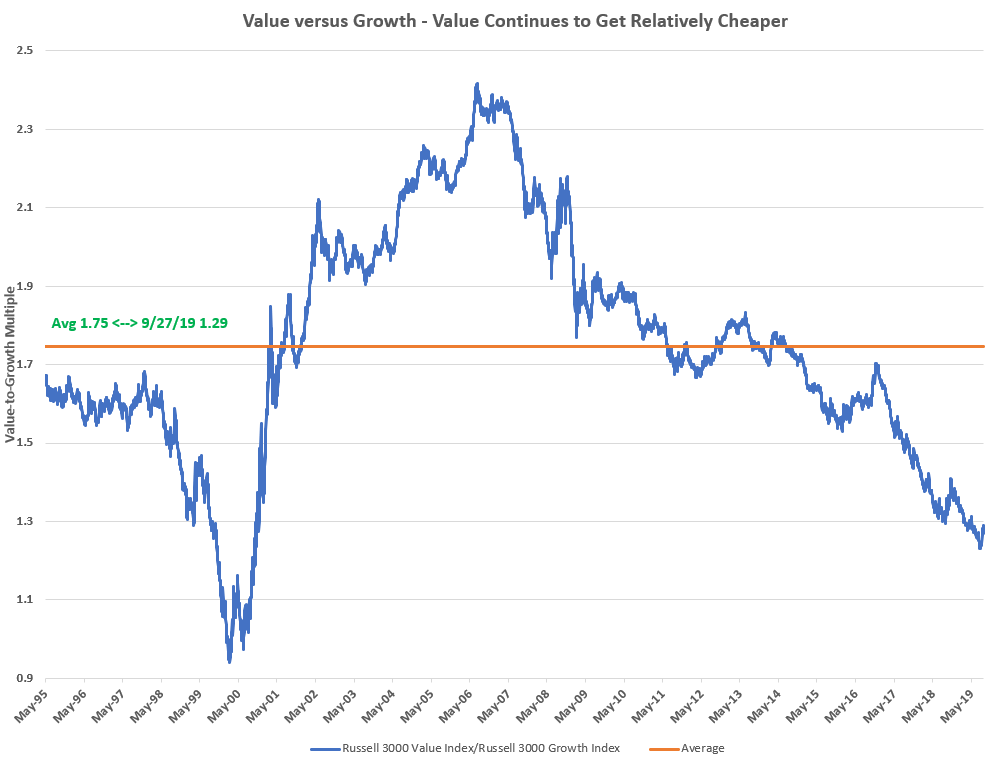Investor Insights:
- Growth stocks have been outperforming value stocks for many years now.
- However, value stocks have beaten their faster-growing peers since August 27.
- So, value or growth? I encourage you to enjoy the best of both worlds.
Financial pundits and the media act like value stocks and growth stocks are from two different planets.
And they try to lump investors into one of the two camps.
I wish that wasn’t the case, because investors like you suffer from that type of thinking.
Value and growth aren’t from different worlds. They’re more alike than they are different.
In this essay, I’ll tell you how.
I’ll also show you how there was just an amazing turning point in the relationship between these two types of stocks.
Finally, I’ll explain how this can make you some serious money in the months ahead.
Growth Versus Value
Growth stocks are growing their sales. And value stocks are cheap based on some other metric.
At the end of August, the top three holdings of the Russell 3000 Value Index were Berkshire Hathaway, JPMorgan Chase and Exxon Mobil.
For the comparable growth index, the top three were Microsoft, Apple and Amazon.
The top growth stocks are all tech stocks. It’s safe to say the value names are stodgier in nature.
At Banyan Hill’s annual conference, an attendee suggested that people could think of value stocks like the tortoise and growth stocks like the hare from the famous fable. And I agree with him.
I suggest you try to find stocks that exhibit traits of both animals.
Relative Performance
Growth stocks have been outperforming value stocks for many years now.

This chart shows the ratio of the Russell 3000 Value Index divided by the growth index.
The value index peaked versus the growth index in August 2006. Since then, growth stocks have outperformed their value-priced peers.
However, this changed recently:
Value stocks bottomed on August 27. During the month since, they’ve outperformed their faster-growing peers.
Value is up 5.6% over that stretch versus 0.8% for growth.
Recognize the Historical Parallels
First, you should recognize this is a unique event.
We haven’t seen value move this much versus growth stocks since the end of September last year.
From September 27 to November 19, 2018, value stocks outperformed growth stocks by nearly 8%.
Next, you should compare this event to the mother of all recent value bottoms.
As you can see in the first chart, after value bottomed versus growth in March 2000, it went on a run. Value peaked relative to growth in early August 2006.
Over the stretch, value stocks outperformed growth stocks by 90% (before dividends). Value stocks rose 48% while growth fell 42%.
What You Should Do With This Information
If you’re wondering if value is going to outperform growth for the next several years, that’s a great question.
Last year, value’s outperformance only lasted for two months.
But after so many years of big gains in growth stocks, value is in a position to go on a longer run.
And if value outperforms growth going forward, you may need to assess whether you have enough of it in your portfolio.
I encourage you to get some more exposure to value. But I also encourage you to enjoy the best of both worlds.
You can do that by buying a reasonably priced stock that’s growing too.
The Best of Both Worlds
One of the stocks with the best price-to-free-cash-flow ratios is Interactive Brokers Group Inc. (IEX: IBKR).
Some of you may buy and sell stocks on Interactive Brokers. It’s a great company.
At 1.67 on Tuesday, its ratio was the 22nd lowest of all the stocks in the Russell 3000 Value Index.
Shares fell on Tuesday when Charles Schwab announced it will offer no-commission stock trades.
I don’t believe the sell-off was warranted, though. Interactive Brokers plans to offer free trades too.
It told the market so late last week. Shares fell 9% anyway.
Whether you require more exposure to value investing or not, this is a solid, low-priced stock to add to your portfolio.
You should consider buying shares today.
Good investing,
Brian Christopher
Editor, Insider Profit Trader
P.S. I spoke with my colleague Jeff Yastine about this topic at Banyan Hill’s Total Wealth Symposium. You can watch our seven-minute talk by clicking on the video below:
